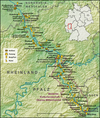Reichenstein Castle (Trechtingshausen)
| Reichenstein Castle | |
|---|---|
Burg Reichenstein | |
| Trechtingshausen | |
 | |
| Coordinates | 50°0′18.5″N 7°51′12.6″E / 50.005139°N 7.853500°E |
| Type | Medieval castle |
| Site history | |
| Built | 1100 |
Reichenstein Castle (Template:Lang-de) is a castle near the town of Trechtingshausen in Rhineland-Palatinate, Germany.
History
Situated on a rocky ridge, Rheinstein Castle rises approximately 270 feet above the River Rhine in the Loreley Valley. Originally built around 900 A.D. to serve as a customs post for the German Empire, it was referred to as either the Vogtsburg ("Advocate's Castle") or Feitsburg.
The castle was home to the Holy Roman Emperor, Rudolph of Habsburg, from 1282 through 1286. Here he passed judgment on the unruly robber knights at the castles of Reichenstein, Sooneck and Ehrenfels. In addition, Rudolph of Habsburg founded the Noble Knighthood and renamed the castle, Königstein. From the 14th to 17th century, the castle was leased to the archbishops of Mainz. However, it began to fall into disrepair after 1572 when it became unprofitable for Anton von Wiltberg, chamberlain in Mainz, to maintain its upkeep.
In 1823, the castle ruin and its foundation stone were purchased by Prince Frederick of Prussia, nephew of King Frederick William III. Thereafter, the castle was rebuilt under the direction of famous castle architect, Claudius von Lassaulx. It was renamed Rheinstein Castle due to its imposing rocky location above the Rhine. Since 1975, Rheinstein Castle has been privately owned by the Hecher family who repaired and restored the castle over a period of 19 years to regain its glory from days long ago.
Description
Burg Rheinstein possesses a working drawbridge and portcullis, which are typical of medieval castle architecture and defences. The castle is open to the public. Just past the gift shop near the entrance is an opening on the left to the courtyard, which offers a spectacular view of the Rhine. Rheinstein's courtyard is known as the Burgundy Garden after the Burgundy grape vine growing there. The vine, which is approximately 500 years old, still produces grapes.
From the garden, steps lead down to the castle chapel. In the centre of the Gothic altar piece of the chapel there is a woodcarving depicting Jesus at the Last Supper. Between the rock and chapel, additional steps lead down to the royal crypt of Prince Frederick William Louis's family.
Heading upwards to the Burgundy Garden, another set of steps lead to the main part of the castle. The largest and most impressive room at Rheinstein Castle is located at the top of the stairway to the left once inside the castle. Known as the Rittersaal or Knight's Hall, it includes beautiful stained glass windows, as well as three-dimensional paintings. Rheinstein houses a cafe and gift shop offering miniature handmade wooden treasure chests, as well as traditional items including postcards and guidebooks for purchase.

